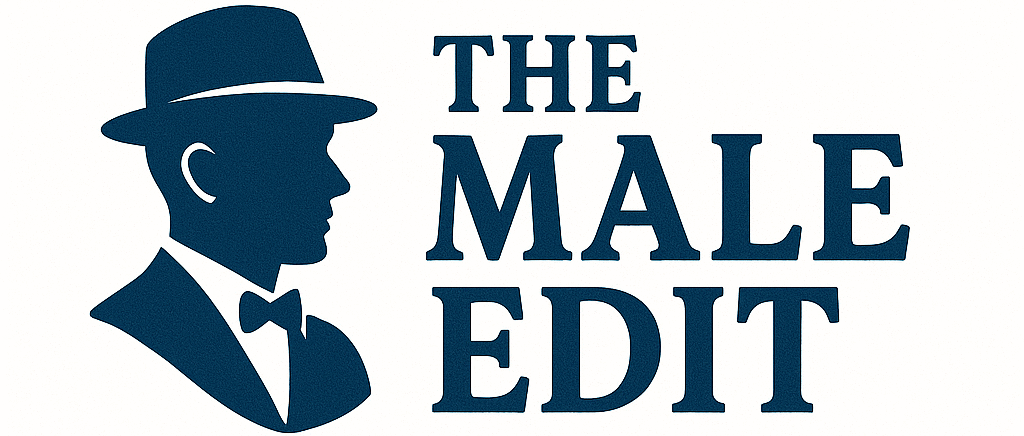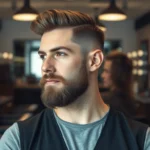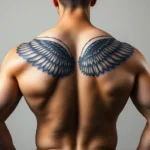We’ve all seen that perfectly groomed man walking down the street whose beard makes us stop and stare. The secret behind that flawless look? A well-executed fade beard style that transforms an ordinary beard into a masterpiece of modern masculinity.
Fade beard styles have revolutionized men’s grooming by seamlessly blending different hair lengths to create depth dimension and sophistication. These styles offer the perfect balance between rugged masculinity and refined elegance making them ideal for everything from boardroom meetings to weekend adventures.
Whether you’re dealing with patchy growth or simply want to elevate your current beard game we’re here to guide you through the most popular fade beard styles that’ll have you looking sharp and confident. From subtle tapers to dramatic contrasts these techniques will help you discover the perfect fade that complements your face shape and personal style.
What Are Fade Beard Styles and Why They’re Trending
Fade beard styles represent a modern grooming technique where hair gradually transitions from longer lengths to shorter ones, creating a seamless blend that eliminates harsh lines. These styles combine traditional barbering methods with contemporary aesthetics, resulting in a polished appearance that works for professional settings and casual environments alike.
The trending nature of fade beards stems from their versatility and ability to complement various face shapes. Social media platforms like Instagram and TikTok have amplified their popularity, with barbers showcasing intricate fade techniques that demonstrate technical skill and artistic creativity. Men’s grooming standards have evolved significantly, with fade beards offering a middle ground between full beards and clean shaven looks.
Professional barbers create fade beards using multiple clipper guards, typically starting with longer lengths at the top and gradually decreasing to shorter lengths toward the neck and cheek lines. This technique requires precision and expertise, making it a sought after service in barbershops worldwide. The process involves careful blending, attention to natural growth patterns, and understanding of facial structure to achieve optimal results.
Modern fade beard styles address common grooming challenges like patchy growth areas, uneven hair density, and maintaining professional appearance standards. They offer answers for men who want facial hair without committing to full beard maintenance routines. The adaptability of fade techniques allows for customization based on individual preferences, lifestyle requirements, and workplace dress codes.
Celebrity influence has significantly boosted fade beard popularity, with actors, athletes, and musicians sporting various fade styles on red carpets and social media. This visibility has normalized fade beards in mainstream culture, making them accessible to men across different age groups and professional backgrounds. The trend continues growing as barbering techniques become more refined and widely available.
Classic Low Fade Beard Style
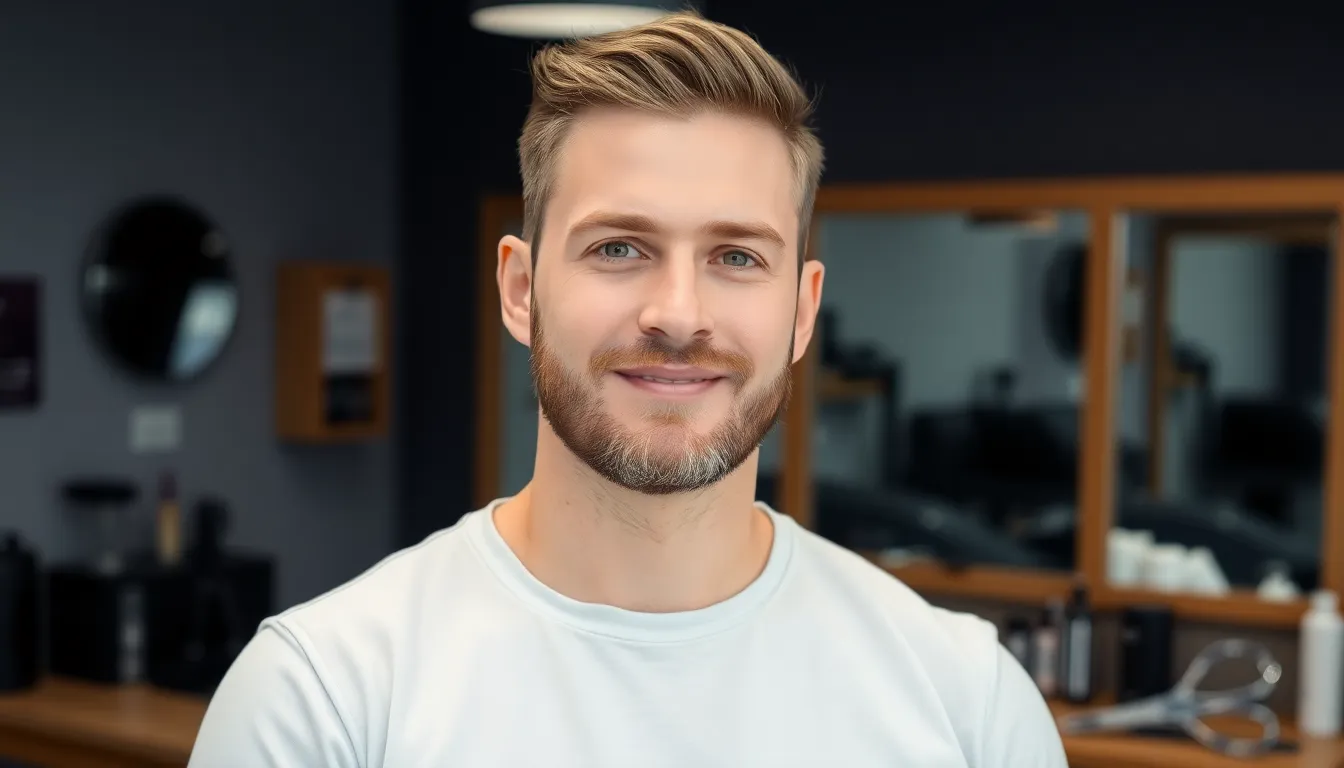
The classic low fade beard style offers a sophisticated approach to facial hair grooming that perfectly balances ruggedness with refinement. This versatile technique features a gradual taper starting just below the lower lip and fading down toward the jawline, maintaining fuller beard hair closer to the chin while creating a clean transition near the sideburns and neckline.
How to Achieve the Perfect Low Fade
Start with adequate beard length of 3-6 inches to provide sufficient hair for smooth tapering and blending. Your foundation determines the success of the entire fade process.
Begin the fade at the lower lip area using progressively shorter clipper guard lengths as you move toward the jawline and neck. We recommend starting with longer guards and gradually working down to create that seamless gradient effect.
Maintain a horizontal fade line that aligns cleanly with the top of your sideburns and jawline to avoid harsh edges. This contour should flow naturally with your facial structure rather than fighting against it.
Focus on seamless blending by combining multiple clipper guards with precision trimming around the sideburn and cheek areas. The transition should appear effortless and natural to the eye.
Schedule regular maintenance every 1-2 weeks to preserve the sharpness of your fade and overall beard shape. Consistent upkeep prevents the style from losing its defined appearance.
Best Face Shapes for Low Fade Beards
Square and rectangle faces benefit significantly from low fade beards as they elongate facial proportions by removing bulk from the cheeks while maintaining strong jawline definition. The style creates vertical emphasis that balances angular features.
Round faces appear more angular and defined with this technique since it emphasizes the chin area while creating sharper facial contours. We’ve found it particularly effective for narrowing wider face shapes.
Oval faces maintain their natural balance and symmetry with low fade beards, as the style enhances existing proportions without adding unnecessary width or bulk to the sides.
Customization options make this style adaptable to nearly any face shape through strategic adjustments in fade height and overall beard length. Your barber can modify the technique to complement your unique facial structure perfectly.
Medium Fade Beard with Full Coverage
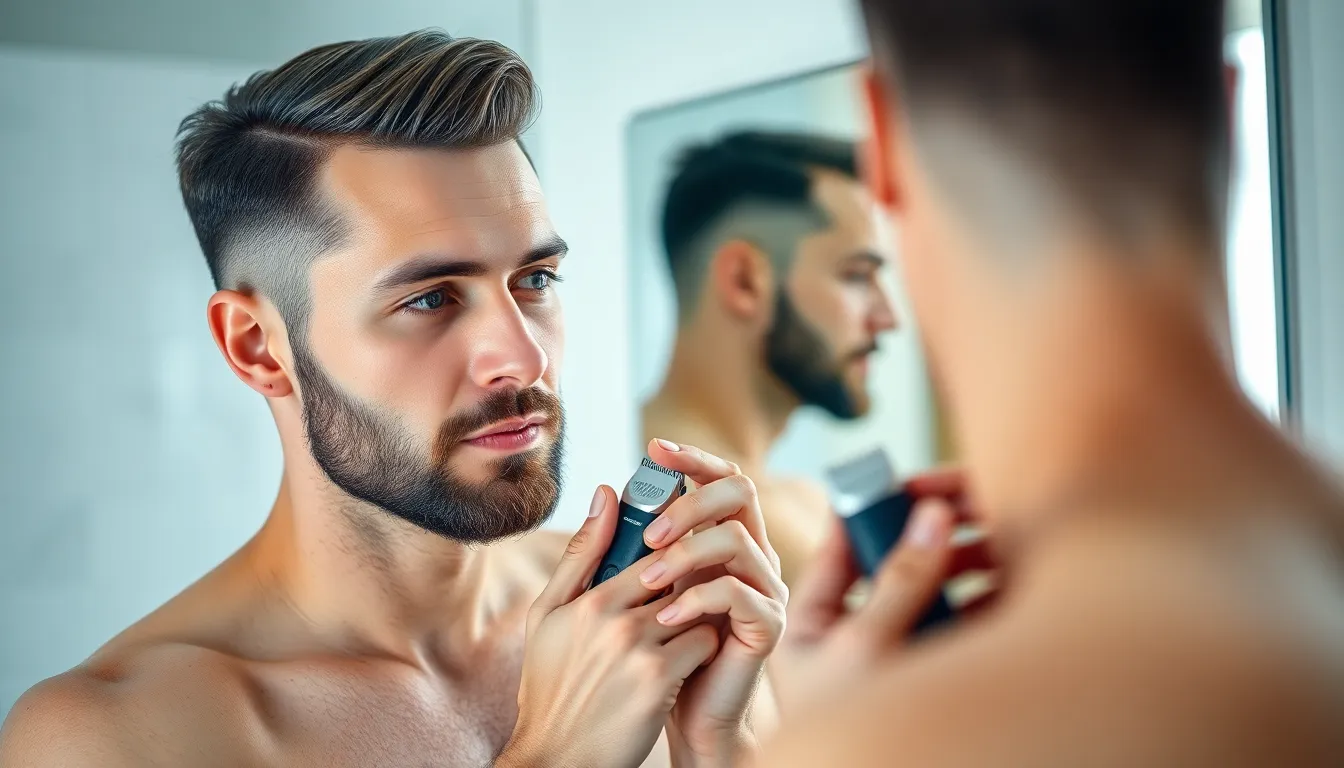
A medium fade beard creates a versatile and polished look by gradually decreasing hair length from the cheeks down to the neck. This style offers more dramatic contrast than low fades while maintaining professional appeal across various face shapes and hairstyles.
Styling Tips for Medium Fade Beards
Blend transitions smoothly by using progressively lower guard settings as you move down your face. Start with your desired length at the top and reduce the guard size incrementally to create seamless zones where different lengths meet.
Define sharp edges around your cheekbones and neckline using precision trimmers or razors. We recommend establishing clean lines that follow your natural jawline structure for the most flattering appearance.
Master the gradient technique by working in small sections and constantly checking your progress. Move the trimmer in upward motions against hair growth to achieve the most even results throughout the fade zones.
Moisturize consistently to prevent itchiness and enhance your beard’s overall appearance. Quality beard oils and balms help maintain healthy hair texture while making the fade transitions appear more refined.
Check symmetry frequently by examining both sides of your face in good lighting. We suggest using a handheld mirror alongside your bathroom mirror to catch any uneven areas before they become noticeable.
Maintenance Requirements
Trim every 1 to 2 weeks to maintain sharp fade lines and prevent your beard from losing its defined structure. Regular maintenance sessions keep the gradient looking intentional rather than grown out.
Clean up edges weekly around your cheeks and neck area to preserve that crisp, professional appearance. We find that maintaining these boundaries prevents the style from looking unkempt between full trimming sessions.
Wash and condition regularly to keep your beard hair healthy and manageable during styling sessions. Clean facial hair responds better to trimming and holds its shape longer throughout the day.
Invest in quality tools including multiple clipper guards and precision trimmers for optimal results. Professional grade equipment makes achieving consistent fade transitions significantly easier than using basic grooming tools.
Schedule professional touch ups every 4 to 6 weeks if you’re new to fade maintenance. Experienced barbers can correct any mistakes and teach you techniques for better home maintenance between visits.
High Fade Beard for Bold Statements
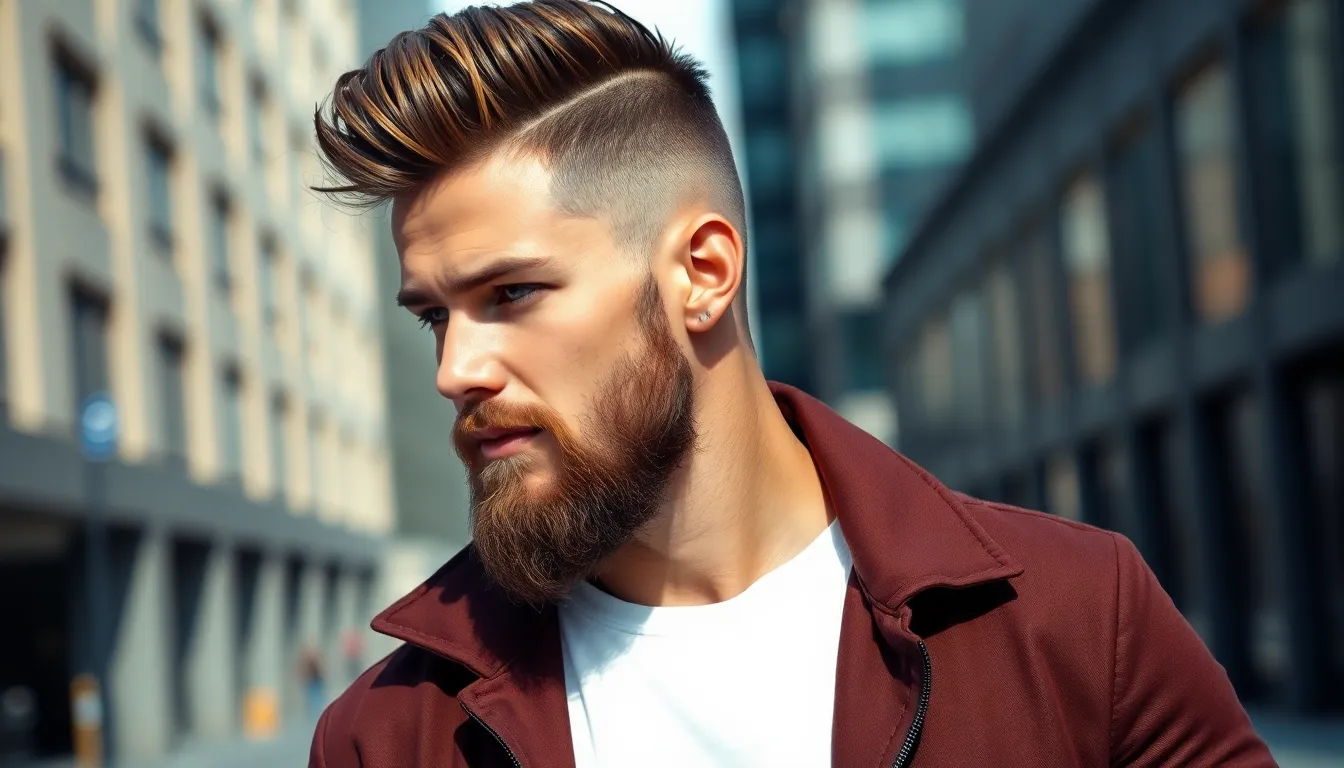
The high fade beard represents the most dramatic and attention-grabbing option in fade styling, starting the transition near the temples and creating a striking visual impact. This style perfectly suits men who want to make a confident statement while maintaining sophisticated grooming standards.
Creating Sharp Contrast Lines
Sharp contrast lines define the essence of a high fade beard, creating visually striking effects that emphasize your jawline and facial structure. We achieve this bold look by establishing clear demarcation points between the skin fade and fuller beard sections, resulting in a sophisticated edge that demands attention.
Modern barbering techniques focus on precise blending while maintaining these bold edges, requiring exceptional skill to execute properly. The contrast lines add angular definition that’s particularly effective for square and round face shapes, creating height and improving your natural features.
Professional barbers use specialized techniques to ensure these lines remain crisp and well-defined, making the fade appear seamless yet dramatically distinct. This approach transforms a standard beard into a statement piece that showcases meticulous grooming attention.
Professional vs. Casual High Fade Looks
Professional high fade beards emphasize subtle sophistication through carefully blended transitions and well-groomed edges. We recommend pairing this refined version with sleek hairstyles like side parts or polished tops to maintain appropriate business environment standards.
Subtle blending techniques create a more conservative appearance while preserving the style’s modern appeal. This professional approach focuses on clean lines without overwhelming sharpness, ensuring workplace appropriateness.
Casual high fade beards embrace bolder attitudes with sharper contrast lines and often fuller beard lengths. This confident, masculine approach works perfectly for social settings where making a statement enhances your personal style.
Edgy haircut pairings like faded buzz cuts or skin fades complement the casual high fade beard, creating an overall trendy and rebellious aesthetic. We find this combination particularly effective for men who want to showcase their individuality through distinctive grooming choices.
The casual version allows for more experimental approaches, including varying beard lengths and more pronounced fade transitions that create maximum visual impact.
Skin Fade Beard Style for Maximum Impact
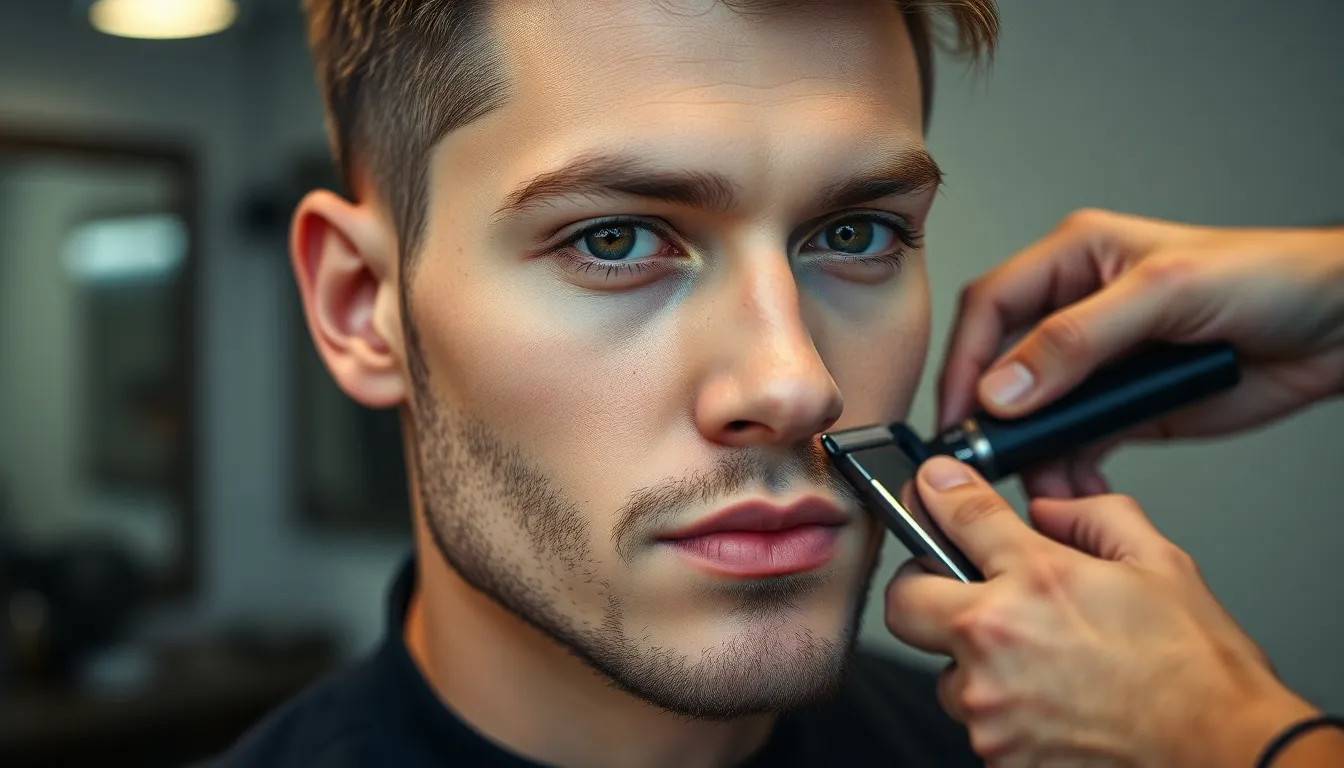
We take fade beard styling to its most dramatic level with the skin fade technique, where the beard gradually disappears into bare skin for an incredibly sharp and defined look.
Zero Guard Techniques
Zero guard techniques deliver the most dramatic contrast in skin fade beard styling by using clippers without any guard attachment. We apply this method at the bottom of sideburns and along the neckline where the fade transitions to completely bare skin. Precision becomes crucial when working with zero guard settings since there’s no margin for error.
Clipper control requires steady hands and deliberate movements to avoid creating uneven patches or nicks in the skin. We recommend starting with longer guards and gradually working down to the zero setting to maintain better control throughout the process. Professional barbers often use this technique as the final step to achieve that crisp, clean finish that defines a true skin fade.
The zero guard creates sharp definition around the cheeks and neck areas, establishing clear boundaries between the beard and bare skin. We focus on maintaining consistent pressure and angle while moving the clippers to ensure even coverage. This technique works best on clean, prepped skin that’s been softened with beard oil for smoother trimming.
Blending Methods for Seamless Transitions
Blending starts with longer clipper guards and progresses to shorter lengths as we move toward the fade line. We begin with guard sizes like #3 or #4 and gradually reduce to #2, #1, and finally zero guard for the smoothest possible transition. Circular motions help eliminate harsh lines between different beard lengths.
Back and forth movements create the feathering effect that’s essential for professional looking fades. We switch between guard sizes frequently while checking our progress in the mirror to ensure symmetry on both sides. The key lies in overlapping each pass slightly to avoid creating visible steps in the fade.
Mirror checks become critical throughout the blending process to maintain even proportions and catch any inconsistencies early. We recommend using a handheld mirror plus to your main mirror to view the fade from multiple angles. After completing the blend, precision trimmers clean up the edges for that polished, barbershop quality finish.
Moisturizing the skin after fading keeps the area healthy and enhances the overall appearance of the skin fade beard style. We apply a light moisturizer or aftershave balm to soothe any irritation from the close trimming process.
Disconnected Fade Beard Styles
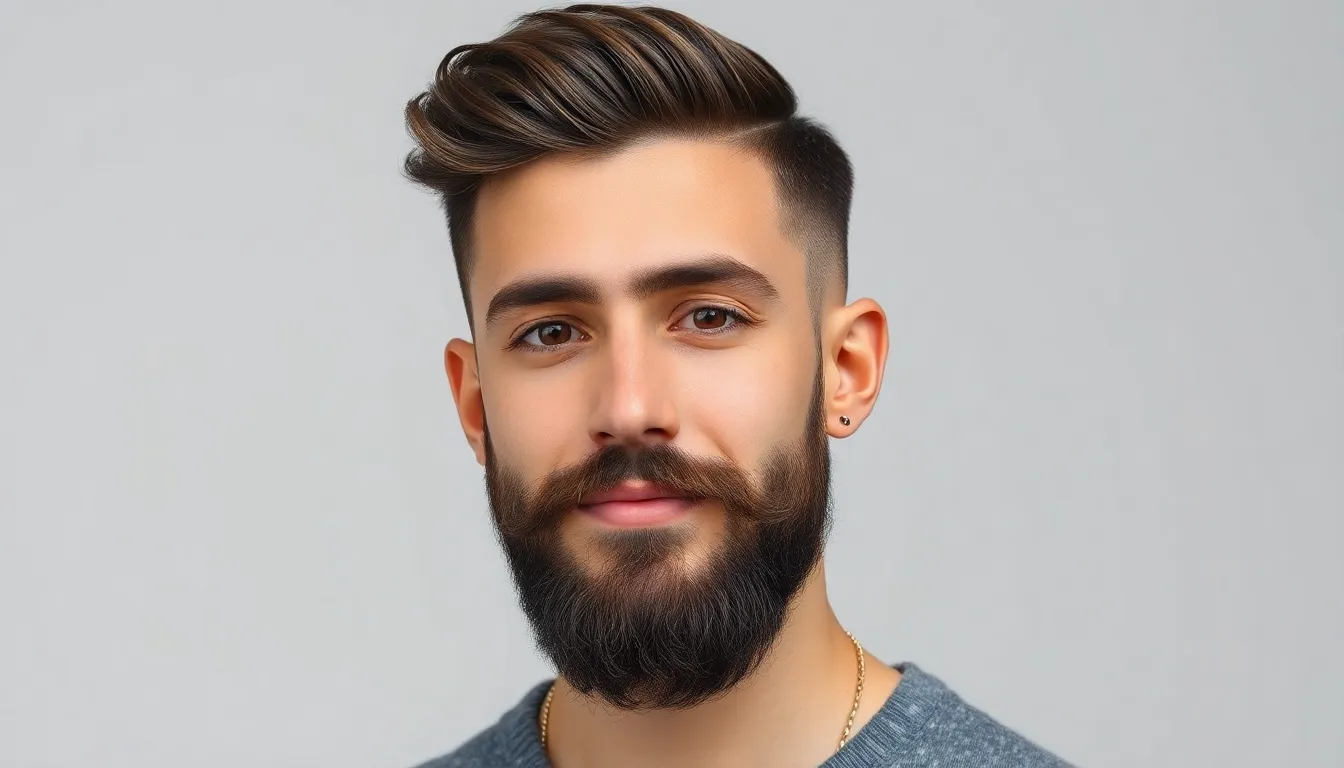
Disconnected fade beard styles break away from traditional blending techniques by creating a distinct separation between your beard and hairline. This bold approach emphasizes sharp contrasts and defined edges that make your facial hair the star of your overall look.
Modern Hipster Variations
Modern hipster beard fades combine vintage aesthetics with contemporary grooming precision to create truly unique styles. These variations typically feature textured hair on top paired with fuller mustaches that complement the faded beard edges below.
High cheek fades start the transition near your temples and create a dramatic shadow effect that appears both natural and intentional. We’ve seen this technique work particularly well with longer, styled hair that adds volume and movement to the overall look.
Textured top combinations blend messy, tousled hair with precisely faded beard edges for that effortlessly cool appearance. Your barber will focus on softening the beard’s perimeter while maintaining fuller growth in the chin and mustache areas.
Creative blending techniques allow for experimental approaches like asymmetrical fades or varying fade depths on different sides of your face. These artistic interpretations appeal to men who want their facial hair to make a statement while maintaining professional versatility.
Fuller mustache pairings work exceptionally well with disconnected fades because they create a balanced focal point. The contrast between the faded cheek area and the robust mustache draws attention to your mouth and jawline in a flattering way.
Combining Fades with Mustache Styles
Combining beard fades with exact mustache styles enhances your facial symmetry while adding personality to your grooming routine. This fusion technique allows you to experiment with classic mustache shapes alongside modern fading methods.
Hollywoodian beard combinations feature an extended goatee with a full mustache and wide chinstrap, creating clean defined edges when paired with a fade. The minimal sideburn area works perfectly with disconnected fade techniques because it naturally creates that sharp contrast we’re looking for.
Mustache area fading requires careful attention to avoid overwhelming your facial features with too much contrast. We recommend starting with longer guard lengths near the mustache and gradually decreasing as you move toward the cheek area.
Balance maintenance becomes crucial when working with prominent mustache styles and faded beard edges. Your barber should trim the fade areas more frequently than the mustache to prevent the look from becoming uneven or overwhelming.
Precision trimming techniques focus on creating clean lines where the fade meets the mustache without sacrificing the natural flow between these areas. This attention to detail ensures your combined style looks intentional rather than accidental.
Classic shape experiments let you try traditional mustache forms like the handlebar or chevron while incorporating modern fade elements for a truly personalized appearance. These combinations work best when the fade complements rather than competes with your chosen mustache style.
Temple Fade Beard Combinations
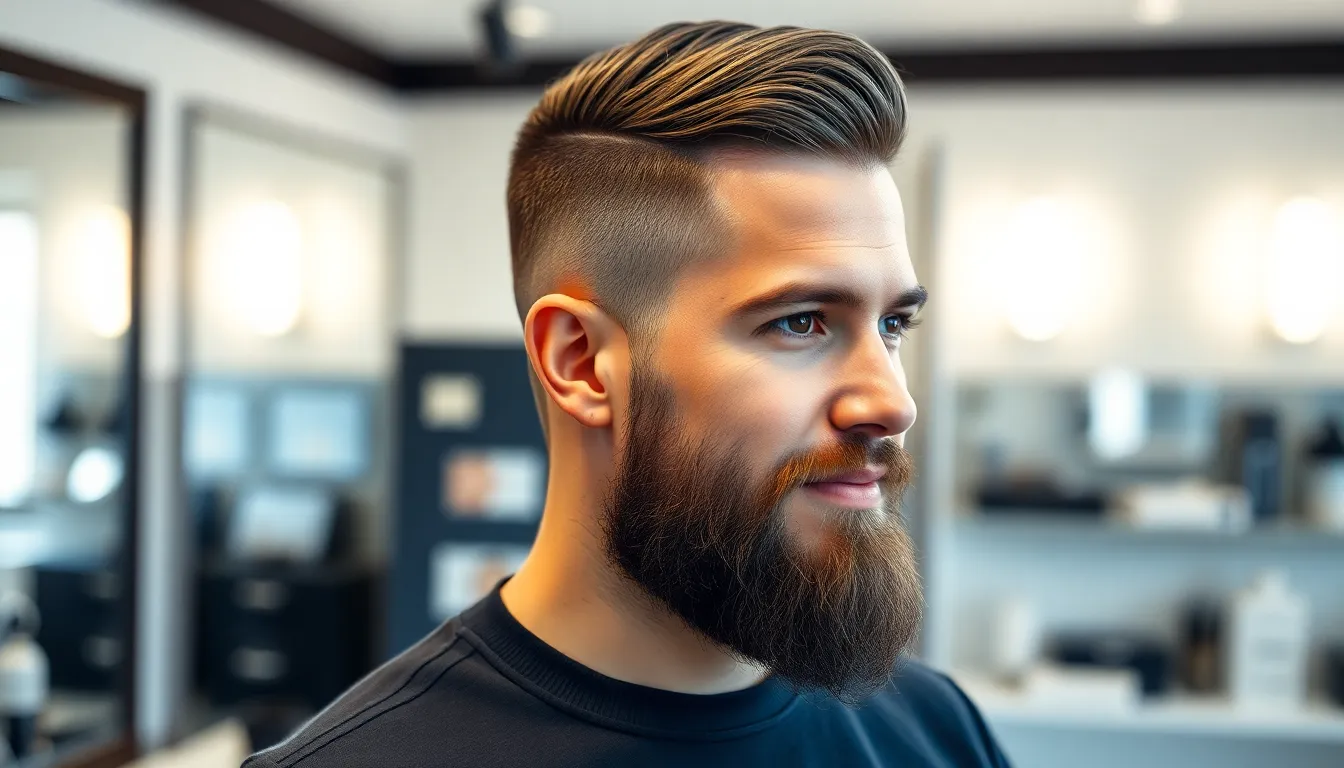
Temple fade beard combinations create sophisticated styling options by tapering hair from the temple area down into the beard for a cohesive, structured appearance. We’ll explore how to integrate these techniques with complementary elements for maximum visual impact.
Side Part Integration
Side part integration with temple fade beards elevates sophistication while maintaining perfect symmetry across your facial structure. We recommend keeping the side part razor sharp to create contrast against the gradual fade that transitions smoothly from your sideburns into the cheek and chin areas. This combination delivers a classic yet contemporary aesthetic that works equally well for professional meetings and casual weekend gatherings.
Professional barbers often emphasize the importance of balancing both sides of your face when implementing this style. The side part complements the temple fade by maintaining structural integrity while the beard fade flows naturally downward. We’ve found that men with square or rectangular face shapes benefit most from this pairing since the sharp angles of the side part work harmoniously with the temple fade’s natural contours.
Maintaining balance requires consistent attention to both the hairline and beard edges throughout the styling process. The side part should align perfectly with your temple fade’s starting point to create an unbroken visual line that enhances your overall appearance.
Maintaining Clean Lines
Maintaining clean lines becomes essential for preserving the sharp angles and intentional appearance that define temple fade beard combinations. We recommend trimming your cheek line, neckline, and side part regularly to ensure the style remains crisp and professionally executed. Precision trimmers work best for following your face’s natural contours while avoiding patchiness or uneven growth patterns.
Regular maintenance schedules help prevent the fade from losing its seamless blending effect over time. Professional barber services often provide optimal results for achieving the sharpest lines and smoothest transitions that temple fades demand. We suggest scheduling touch ups every 2 to 3 weeks to maintain the style’s integrity and visual impact.
Quality grooming tools make a important difference in your ability to preserve clean edges between salon visits. Investing in precision trimmers and learning proper technique ensures your temple fade beard combination continues looking sharp and intentional throughout its growth cycle.
Choosing the Right Fade Beard Style for Your Face Shape
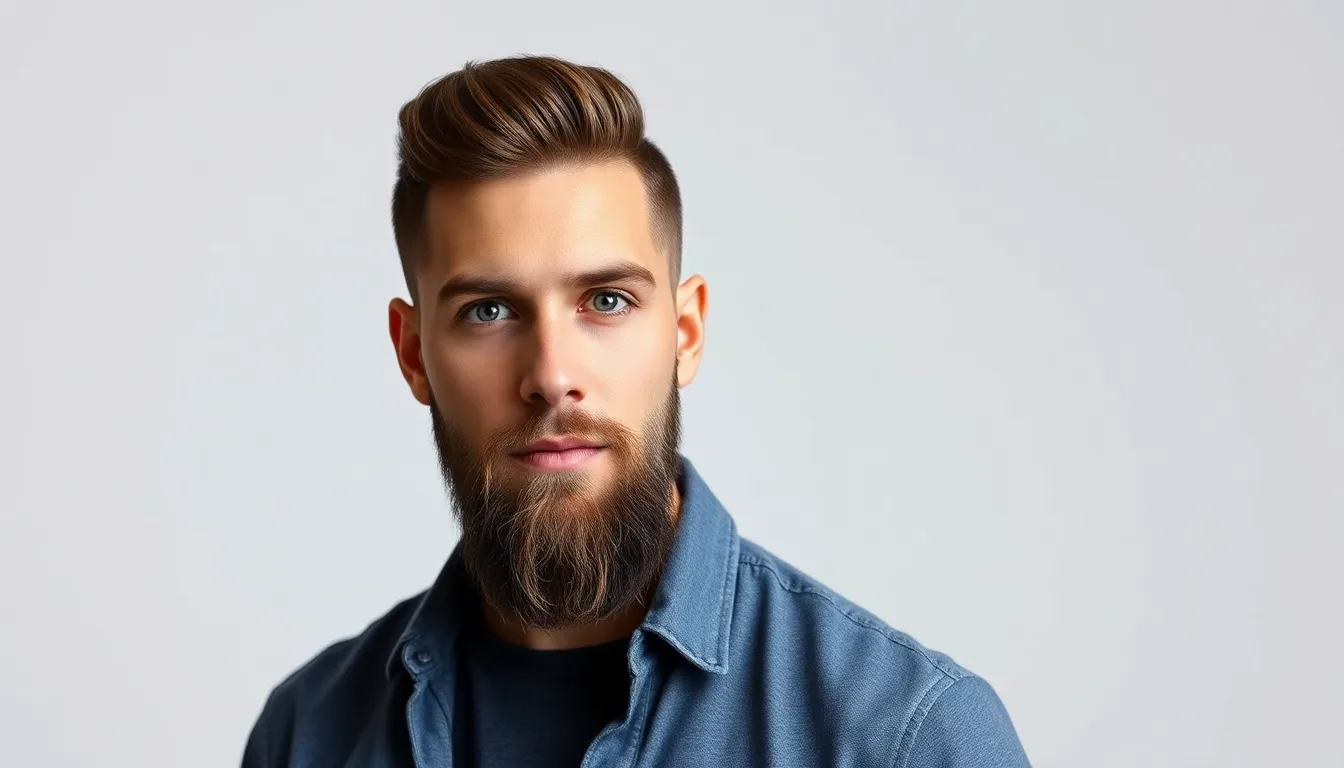
Your face shape determines which fade beard style will enhance your natural features and create the most flattering appearance. We’ll guide you through the optimal fade styles for different face shapes to help you achieve the perfect look.
Round Face Recommendations
Sharp, tapered fades work best for round faces by adding definition and creating the illusion of length. Our goal is to elongate your face while avoiding styles that add width to the cheeks.
Opt for fade beards that taper to a point below the chin to draw the eye downward and create vertical lines. This technique helps balance the natural roundness of your face shape.
Avoid chinstrap beards or styles with excessive fullness on the sides as these can make your face appear even rounder. Instead, focus on maintaining clean lines that emphasize your jawline without adding bulk to the cheek area.
Keep the fade transition sharp and well-defined to create structure and prevent your beard from looking too soft or rounded. Regular maintenance every 1-2 weeks ensures your fade maintains its crisp appearance.
Square Face Optimal Styles
Chin-length fade beards soften angular jawlines and prevent square faces from appearing too harsh or boxy. We recommend styles that add gentle curves while maintaining masculine definition.
Choose faded beards with slightly longer length at the chin to balance your prominent jaw and create visual harmony. Short stubble fades or partial beard fades work exceptionally well for this face shape.
Avoid very full or wide beards that cover your jawline since this eliminates one of your best features. Your strong jaw is an asset that should be enhanced, not hidden.
Focus on creating smooth transitions from your sideburns to your jawline to soften harsh angles. This blending technique helps create a more balanced and approachable appearance.
Oval Face Versatile Options
Oval faces accommodate almost any fade beard style making this the most flexible face shape for experimenting with different looks. Your natural facial balance allows for creative freedom in styling choices.
Try short boxed fades, corporate styles, stubble fades, or even Verdi beards as your proportioned features support various fade techniques. The key is ensuring your fade starts at the sideburn and transitions smoothly toward your jaw or neck.
Experiment with different fade heights and lengths since oval faces have few restrictions. You can adjust the style based on your personal preference and lifestyle needs.
Consider your professional requirements and personal style when choosing from the wide range of options available to you. Your versatile face shape means you can adapt your fade beard to match different occasions and settings.
| Face Shape | Optimal Fade Style | Avoidance Tips |
|---|---|---|
| Round | Sharp, tapered fade | Wide, full cheek hair |
| Square | Chin-length fade, stubble | Very wide beards |
| Oval | All fade beard options | None (very flexible) |
Professional Grooming Tips for Fade Beard Maintenance

Maintaining your fade beard requires consistent attention and the right approach to preserve its sharp, polished appearance. Professional techniques ensure your fade remains seamless while keeping your facial hair healthy and well-defined.
Essential Tools and Products
Quality clippers serve as the foundation of any successful fade beard maintenance routine. We recommend investing in professional-grade trimmers with multiple guard sizes to achieve precise length transitions. Adjustable blade systems allow for better control when creating seamless blends between different hair lengths.
Sharp razors become crucial for maintaining clean skin fade areas and defining precise edges. Straight razors or high-quality safety razors provide the cleanest cuts, while electric shavers work well for quick touch-ups between professional visits.
Beard oil transforms dry, coarse facial hair into manageable, healthy growth that enhances your fade’s overall appearance. Daily application keeps your beard moisturized while preventing irritation in freshly shaved fade areas. Natural oils like jojoba, argan, and sweet almond provide the best conditioning results.
Precision combs and brushes help distribute products evenly throughout your beard while training hair to grow in your desired direction. Boar bristle brushes work best for shorter beards, while wide-tooth combs handle longer, thicker growth without causing breakage.
Professional-grade shaving cream protects sensitive skin during fade maintenance sessions. Quality creams create a protective barrier that reduces razor burn and ensures smooth, comfortable shaves along fade lines.
Weekly Maintenance Routine
Trimming your beard every 2 to 3 weeks maintains the desired shape and prevents uneven growth from disrupting your fade’s clean lines. Start with longer guard settings and gradually work down to shorter lengths, following the original fade pattern your barber created.
Shaving fade edges weekly keeps transitions sharp and prevents hair from growing beyond intended boundaries. Focus on areas where your fade meets bare skin, using light, controlled strokes to maintain crisp definition without over-shaving.
Daily beard oil application should become part of your morning routine to keep facial hair healthy and manageable. Apply 3 to 5 drops to damp beard hair, working the oil through from roots to tips for maximum absorption and conditioning benefits.
Regular styling with proper tools ensures your beard maintains its intended shape throughout the week. Brush or comb your beard after applying oil, training hair to follow the fade’s natural flow while removing any tangles or debris.
Professional touch-ups every 4 to 6 weeks help maintain the technical precision that makes fade beards so striking. Experienced barbers can refresh your fade’s gradient, clean up edges, and address any growth irregularities you might miss during home maintenance.
Common Mistakes to Avoid with Fade Beard Styles
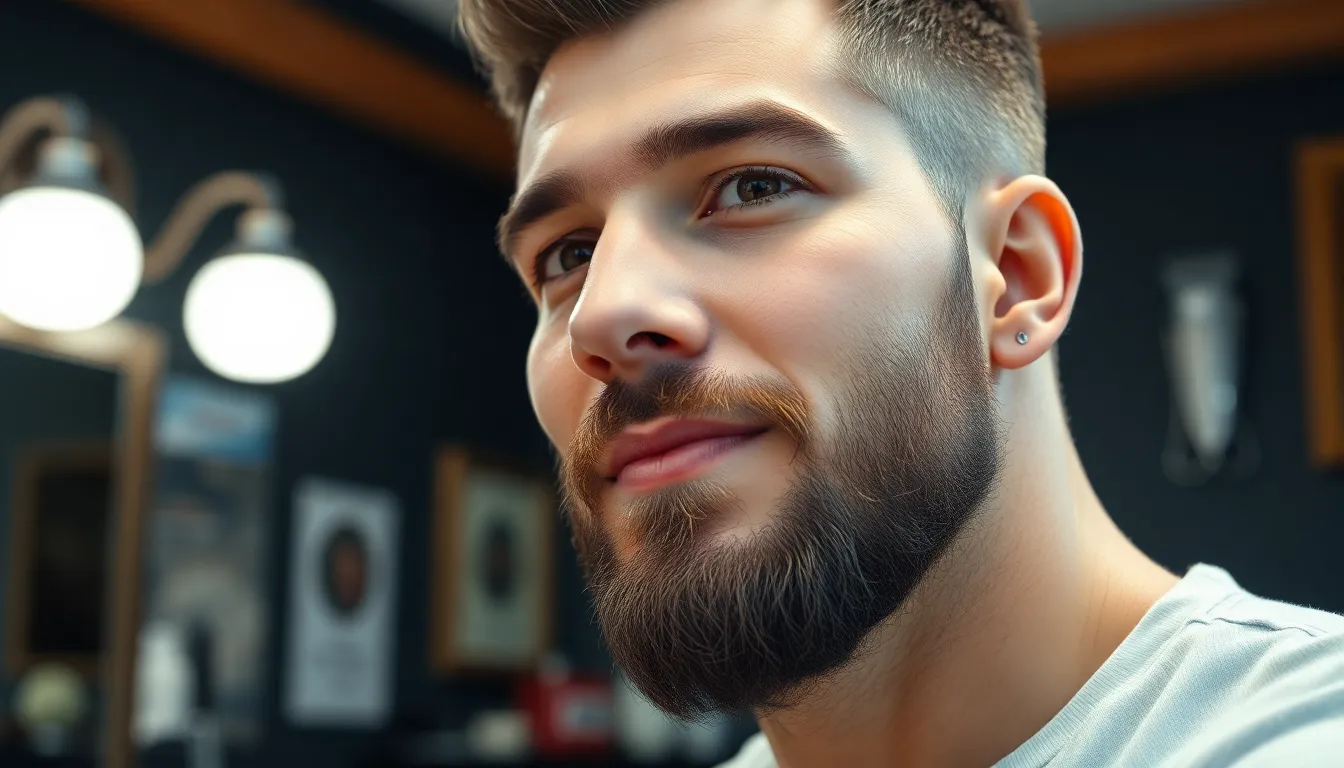
Even experienced groomers can stumble when creating fade beard styles. We’ve identified the most frequent errors that can transform a polished look into an unintentional grooming disaster.
Blending Errors
Uneven blending creates the patchy or disconnected appearance that makes fade beards look amateur rather than intentional. We recommend using a trimmer with a guard to ensure smooth transitions between different hair lengths. Sharp lines where the fade should blend seamlessly indicate rushed technique or improper tool use.
Inconsistent gradient angles disrupt the natural flow of facial hair, creating an unbalanced appearance. Many men rush through the blending process, leaving visible demarcation lines that draw attention away from their facial features. Professional barbers emphasize taking time with each guard length to create the gradual transition that defines quality fade work.
Improper clipper technique often results in choppy or unnatural looking fades that require professional correction. We suggest practicing smooth, overlapping strokes rather than quick, jerky movements that can leave gaps in the fade. Starting with longer guard lengths and gradually working down prevents removing too much hair too quickly.
Length Proportion Issues
Incorrect length distribution disrupts facial symmetry and can make the fade appear unbalanced or poorly planned. The thickest part of the beard should remain at the chin to create a slimming effect on the face, as this positioning enhances natural jawline definition. We’ve observed that many men make their cheek hair too long, which adds bulk rather than creating the desired sculpted appearance.
Disproportionate fade ratios occur when the transition from full beard to faded areas happens too abruptly or too gradually. Fade beard styles work best with a beard length of 3 to 6 inches, allowing for a balanced fade that maintains proper proportions across different facial areas. Going beyond this range often results in either insufficient contrast or overwhelming facial hair volume.
Neglecting face shape considerations leads to fades that work against natural bone structure rather than improving it. Round faces need more aggressive fading on the cheeks to create definition, while square faces benefit from softer transitions that don’t emphasize angular features. We recommend adjusting fade intensity based on individual facial geometry rather than following generic tutorials.
Conclusion
Fade beard styles offer endless possibilities for men looking to elevate their grooming game. We’ve explored how these versatile techniques can transform your appearance while addressing common styling challenges.
The key to success lies in understanding your face shape and choosing the appropriate fade intensity. Whether you opt for a subtle low fade or a dramatic skin fade depends entirely on your personal style and lifestyle needs.
Remember that consistency is crucial for maintaining these sophisticated looks. Regular touch-ups and proper grooming tools will keep your fade beard looking sharp and professional.
We encourage you to experiment with different combinations and don’t hesitate to consult with a professional barber. With the right approach and dedication to maintenance your fade beard will become a defining feature that enhances your overall appearance and confidence.
Frequently Asked Questions
What is a fade beard style?
A fade beard style is a modern grooming technique that creates a gradual transition from longer to shorter hair lengths. This seamless blend eliminates harsh lines and creates a polished, sophisticated look. The fade typically starts with longer hair at the top and gradually decreases in length toward the neck, offering a refined balance between rugged masculinity and elegant styling.
Which fade beard style is best for beginners?
The low fade beard is ideal for beginners because it offers a subtle, sophisticated approach that’s easier to maintain. Starting with 3-6 inches of beard length, it creates a gentle gradient that’s forgiving if mistakes occur. This style provides a good introduction to fade techniques while maintaining a professional appearance suitable for most face shapes and occasions.
How often should I maintain my fade beard?
Fade beards require regular maintenance to preserve their sharp appearance. Trim every 1-2 weeks to maintain the gradient, perform weekly edge clean-ups for crisp lines, and apply beard oil daily to keep hair healthy. Professional touch-ups every 4-6 weeks are recommended to ensure the fade remains well-defined and polished.
What face shape works best with fade beard styles?
Fade beard styles are versatile and complement various face shapes. Square and rectangular faces benefit from elongated proportions, while round faces appear more angular and defined. Oval faces maintain natural balance with most fade styles. The key is choosing the right fade intensity and placement to enhance your facial structure.
Can I achieve a fade beard at home?
While basic fade maintenance is possible at home with quality clippers and practice, achieving the initial professional-looking fade requires skill and precision. Professional barbers use specialized techniques and multiple clipper guards to create seamless transitions. For best results, especially for dramatic styles like skin fades, professional services are recommended initially.
What’s the difference between low, medium, and high fade beards?
Low fade starts the transition lower on the face, creating subtle sophistication. Medium fade begins around mid-cheek level, offering versatile styling options. High fade starts near the temples for maximum dramatic impact. Each style offers different levels of contrast and visual impact, allowing you to choose based on your preference and lifestyle.
How do I choose between different fade beard styles?
Consider your face shape, lifestyle, and maintenance commitment. Round faces benefit from sharp, tapered fades for definition. Square faces work well with chin-length fades to soften angular features. Oval faces can experiment with various styles. Also consider your professional environment and how much time you can dedicate to regular maintenance and styling.
What tools do I need for fade beard maintenance?
Essential tools include quality clippers with multiple guard attachments, precision trimmers for edge work, sharp razors for clean lines, and beard oil for healthy hair. A good mirror setup and steady hand are crucial. Professional-grade tools provide better results and durability, making them worthwhile investments for consistent maintenance and styling.
